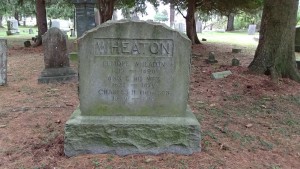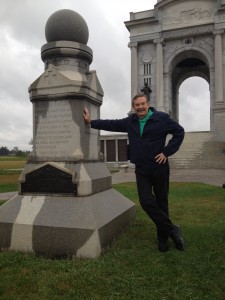 In an earlier post, titled Grave Walking for Julia, I found Elmore Wheaton’s grave. Elmore was my three times great grandmother’s brother-in-law, being married to her younger sister, Ann. After doing some research I determined that Elmore was a good guy and I liked him a lot.
In an earlier post, titled Grave Walking for Julia, I found Elmore Wheaton’s grave. Elmore was my three times great grandmother’s brother-in-law, being married to her younger sister, Ann. After doing some research I determined that Elmore was a good guy and I liked him a lot.
Great-Great-Great Grandma Julia Stevens married Thomas Pixley in 1839 and the newlyweds moved to Wisconsin, where they homesteaded 120 acres of land. I verified their homestead through the General Land Records database at the Bureau of Land Management, which is available online at blm.gov. Their homestead was located in Jefferson County, about half way between Milwaukie and Madison. Thomas drowned on New Year’s Day 1850 while crossing a frozen river, leaving Julia a widow and all alone on the homestead with young children to care for. Having nowhere else to go, Julia returned to live with her sister in the village of Fabius in central New York State. She and her three daughters moved in with Ann and Elmore Wheaton – I know this from the 1855 New York State census. I also know from that census Elmore was a tailor and I know he had a houseful of people; besides Elmore and Ann and their four young children, was now Julia and her three daughters, plus Elmore’s mother-in-law, Ann’s and Julia’s mother – Phena Stevens, who had been living with the Wheaton’s for years – that’s eleven people under one roof … and they didn’t even have one bathroom!
I said Elmore was a good man and I think this, not only because he let his wife’s widowed sister and her three daughters and his mother-in-law stay with him, but also when Julia died Elmore took responsibility to support his three nieces until they grew to adulthood. In that 1855 census I could see that Elmore was already teaching seventeen year old Caroline Pixley a trade, he was a tailor so he was training Caroline to become a seamstress. Five years later, in the 1860 census, Caroline had learned the trade and had become a dress maker.
Before our trip I knew nothing about Elmore, but he now interested me so when I got home I did further research. I found in an old reference book that when Fabius was incorporated the citizens elected Elmore to be president of their newly chartered village, clearly they respected him as well.
Our original reason for coming to central New York State had been to find Julia’s missing grave, so before leaving home I contacted the Onondaga Historical Society for assistance. They thought Julia might be buried in an old cemetery behind the church in Fabius and sent an 1860 grid of the village to help me locate that graveyard.
Since it was lunchtime when we arrived in Fabius, the first thing we did was to stop at Anna’s Country Store for a sandwich. Let me just say, if you are ever in Fabius you must stop at Anna’s for lunch! While in the store I couldn’t help but notice how old the building was, so I asked the owner and she believed it dated from before the Civil War. She said many of the houses in town were that old, so I pulled out my map of 1860 Fabius and, with the sandwich shop owner’s help, realized Elmore’s house should be right next door.
Standing outside we compared today’s houses to the grid map. According to that map Elmore’s house had a cross-shaped footprint, and no such house remained – but Elmore’s neighbor, Elizabeth Button’s house, was “T” shaped on the map and a very old “T” shaped home was still standing where it should be – probably looking much like it had in 1855.
So our stop in Fabius became an unexpected bonus. We were there to find Julia’s grave and we did, but we also discovered Elmore and decided he was a really good guy. We stood in the very location where my family lived 160 years ago (although their house is no longer standing) … and we found a great place for lunch.

 I don’t want to just find my ancestors; I want to discover their life stories and maybe unwind a few family mysteries along the way. Ancestry.com is great for identifying those long dead relatives, but sometimes the best information is not on line at all, sometimes you have to go looking for an original document in a courthouse or church. I love that kind of search, where my reward is finding a document that has been untouched for over a hundred years.
I don’t want to just find my ancestors; I want to discover their life stories and maybe unwind a few family mysteries along the way. Ancestry.com is great for identifying those long dead relatives, but sometimes the best information is not on line at all, sometimes you have to go looking for an original document in a courthouse or church. I love that kind of search, where my reward is finding a document that has been untouched for over a hundred years.
Hi Roger,
Great looking site. I look forward to reading more!
I remember you reading this story at our writing group. You have given some very interesting information that I would not have thought of as far as locating family. What reference book did you use, and where did you find it? You mentioned a reference book. I have passed on your blog site to a friend, so hopefully he will be reading along as well.
Very interesting! It took a lot of work by I’m sure it was well worth it.
Roger> Congratulations to you and Linda on a helpful, interesting, close-to-exciting read about researching on site. The detailed, patient search for Julia and the up-beat resolution read like a book cover for a novel. I especially like the genealogical researcher’s typical experience in which one discovery leads to another subject the researcher can’t resist, enriching the first subject and the writer’s experience. Maybe that familiar experience will have to be considered of equal importance to taking time as you search to talk to local people and ask questions. Nice job.
Love the site cousin Roger and can’t wait to keep reading!